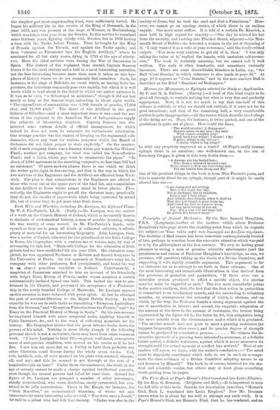Irish Wits and Worthies, including Dr. Lanigan, his Life and
Times. By W. J. FitzPatrick, LL.D. (Duffy.)—Dr. Lanigan was tho author of a work on the Church History of Ireland, which is favourably known to students of ecclesiastical history, a man of notable learning, whose life was worthy of some record. In Mr. FitzPatrick's hands, wide opened as they are to grasp all kinds of collateral subjects, it affords plenty of material for an interesting biography. John Lanigan, then, was a native of Cashel, educated for the priesthood at the Irish College in Rome, his biographer, with a curious use of tenses, says, by way of accounting for this fact, "Maynooth College for the education of Irish Trieste had not been established till the year 1798. His education com- pleted, he was appointed Professor of Hebrew and Sacred Scripture in the University of Pavia. On the approach of Napoleon's army he, in company with other professors, fled precipitately, and found his way in an almost penniless condition to Ireland. Unfortunately, a suspicion of Jansenism attached to him on account of his friendship with Scipio Ricci, Bishop of Pistoia, under whose auspices a certain schismatically inclined Synod was held. This barred the way to pre- ferment in his Church, and prevented his acceptance of a Professor- ship in the newly founded College of Maynooth. Dr. Lanigan appears on this occasion to have behaved with great spirit. At last he obtained the post of assistant-librarian to the Royal Dublin Society. In this capacity he was set to such tasks as translating " Essays on Agriculture from the German," and "Essays on Fisheries from the French," and "An Essay on the Practical History of Sheep in Spain." On his own account he employed himself with more congenial tasks, applying himself to Celtic literature, &c., and to the work of collecting materials for his history. His biographer thinks that his great labours broke down the powers of his mind. Nothing is more likely, though if the following personal sketch is not a caricature, there may have been other causes at work. " I knew Lanigan in later life,—a great, wall-faced, over-grown mass of antiquarian erudition, who moved on his course as if he had fins. I saw him eat more fish on a Friday in Lent than probably any -other Christian could devour during the whole seven weeks. Cod, eels, haddock, sole, all were mashed on his plate with mustard, vinegar. oil, and soy ; and this he seemed to get through at the rate of a hundredweight an hour." Under these circumstances, his death at the age of seventy cannot be made a charge against intellectual pursuits, even though his mental powers had failed for some time. Around the figure of Dr. Lanigan are grouped a number of other personages, chiefly ecclesiastical, who were, doubtless, sorely persecuted, but con- trived to be jolly nevertheless. There is Dr. Keogh, for instance, the "Irish Massillon," an ecclesiastical Sheridan, of whose wit and impecuniosity many interesting tales are told. " You were once a Jesuit," be said to a priest who had left that Society. "Judas was also in the
society of Jesus, but he took the cord and died a Franciscan." How- ever, we cannot go on quoting stories, of which there is an endless supply. One more must suffice. It is told of a certain Dr. Kenrick, man held in high regard for sanctity :—" One day he missed his hat from the sacristy, and rushing into Plunket Street, adjacent—the Mon- mouth Street of Dublin—ho detected a woman in the act of disposing of it. 'I only wanted it as a relic of your reverence,' said the ready-witted culprit. 'You seem very anxious to get rid of it, then.' 'I was only asking the value of it,' replied the female, with unshaken self-posses- sion." The book is certainly amusing, but we cannot call it well written. The style is often bombastic, and sometimes curiously incorrect. There are some discreditable blunders in Latin, e.g., "the Bull 'Com/ Domine,' to which reference is also made at page 30." At page 30 it appears as Ceeni Domini," and in the note another Bull is described as the Brief " Dominus ad Redemptor."






































 Previous page
Previous page